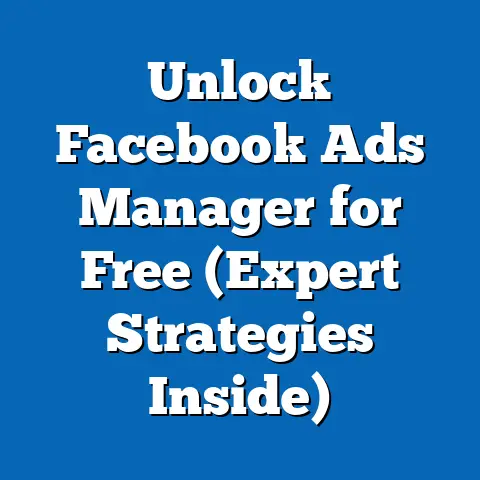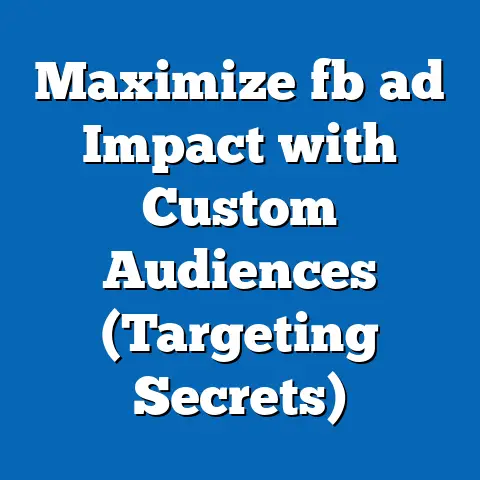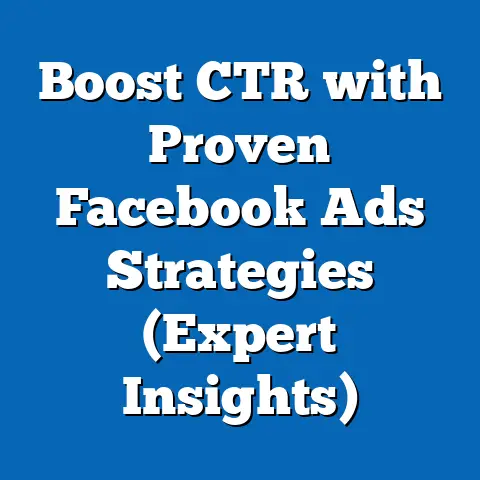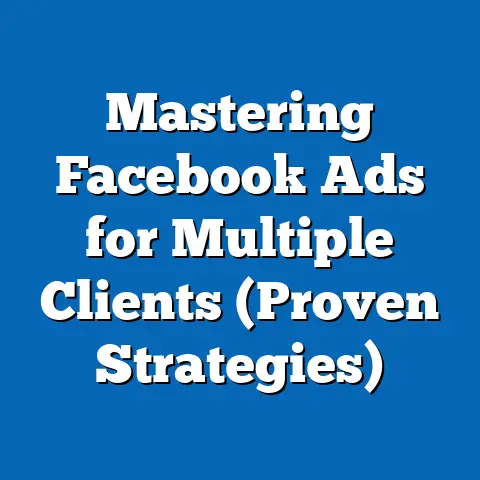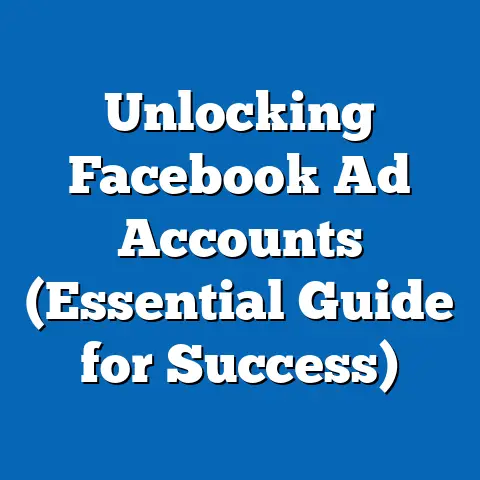Mastering Facebook Ad Funnel (Proven Template Insights)
Let’s face it, we live in a world of constant bombardment. As consumers, we’re hit with thousands of messages every single day, from social media ads to email marketing campaigns. Think about the busy professional, juggling work deadlines, family commitments, and social engagements. They’re constantly scrolling, searching, and sifting through an endless stream of information, desperately seeking products and services that not only solve their immediate needs but also align with their values and aspirations. They crave simplicity, authenticity, and a personal touch in their purchasing decisions.
I’ve seen this firsthand. I’ve worked with countless businesses, from small startups to established enterprises, all struggling to cut through the noise and connect with their target audience on Facebook. The key, I’ve found, isn’t just about creating eye-catching ads; it’s about crafting a carefully orchestrated journey that guides potential customers from initial awareness to final conversion. That’s where the Facebook ad funnel comes in. It’s the secret weapon for turning casual scrollers into loyal customers, and in this guide, I’m going to share my proven template insights to help you master it.
Understanding the Facebook Ad Funnel
I think of it this way: imagine trying to sell a house without a proper showing. You wouldn’t just stick a “For Sale” sign in the yard and expect buyers to line up. You’d stage the home, highlight its best features, and guide potential buyers through each room, painting a picture of the life they could have there. The Facebook ad funnel does the same thing, but in the digital realm.
The funnel typically consists of three key stages:
-
Awareness: This is the top of the funnel, where your goal is to introduce your brand and products/services to a wider audience. You’re essentially casting a wide net to capture the attention of potential customers who may not even know they need your solution yet.
-
Consideration: Once you’ve piqued their interest, the consideration stage is all about educating and engaging your audience. You want to provide them with valuable information, showcase the benefits of your offerings, and position yourself as a trusted authority.
-
Conversion: This is the bottom of the funnel, where you aim to convert interested prospects into paying customers. You’ll be focusing on driving sales, generating leads, and encouraging immediate action.
Awareness: This is the top of the funnel, where your goal is to introduce your brand and products/services to a wider audience. You’re essentially casting a wide net to capture the attention of potential customers who may not even know they need your solution yet.
Consideration: Once you’ve piqued their interest, the consideration stage is all about educating and engaging your audience. You want to provide them with valuable information, showcase the benefits of your offerings, and position yourself as a trusted authority.
Conversion: This is the bottom of the funnel, where you aim to convert interested prospects into paying customers. You’ll be focusing on driving sales, generating leads, and encouraging immediate action.
Why is a structured funnel so critical?
Well, let’s look at the numbers. Studies have shown that businesses with well-defined marketing funnels experience a significant increase in lead generation and conversion rates. In fact, according to a report by MarketingSherpa, companies that nurture leads through targeted content see a 45% higher return on investment compared to those that don’t. That’s a pretty compelling statistic, right?
But beyond the numbers, a structured funnel allows you to personalize your messaging and tailor your ads to each stage of the customer journey. You’re not just blasting out generic ads to everyone; you’re delivering the right message to the right person at the right time. This leads to higher engagement, improved brand perception, and ultimately, more sales.
Takeaway: The Facebook ad funnel is a strategic framework that guides potential customers through the awareness, consideration, and conversion stages, leading to increased lead generation and conversion rates. Start thinking about how you can map out your own customer journey and tailor your ads to each stage of the funnel.
Crafting the Perfect Facebook Ad
Now that we understand the importance of the Facebook ad funnel, let’s dive into the nitty-gritty of crafting the perfect ad. This is where the magic happens, where you have the opportunity to capture attention, spark interest, and drive action.
I’ve seen so many businesses fall flat with their Facebook ads simply because they haven’t paid attention to the key components that make an ad truly effective. It’s not enough to just slap together a product image and a catchy headline. You need to think strategically about your visuals, your copy, and your call-to-action.
Here are the key components of an effective Facebook ad:
- Compelling Visuals: Your visual is the first thing people will see, so it needs to be eye-catching and relevant to your target audience. Use high-quality images or videos that showcase your product or service in the best possible light. Consider using lifestyle imagery that resonates with your target audience’s values and aspirations.
- Engaging Copy: Your ad copy should be concise, clear, and persuasive. Highlight the key benefits of your product or service and address your target audience’s pain points. Use strong verbs and emotional language to capture their attention.
- Clear Call-to-Action (CTA): Tell people exactly what you want them to do. Use a clear and concise CTA button that encourages immediate action, such as “Shop Now,” “Learn More,” or “Sign Up.”
But creating a single “perfect” ad isn’t enough. The real key is A/B testing.
A/B testing, also known as split testing, is the process of comparing two versions of an ad to see which one performs better. You can test different visuals, headlines, ad copy, CTAs, and targeting options to see what resonates most with your audience.
I always tell my clients, “Don’t assume you know what works best. Let the data guide you.”
Here’s how to conduct effective A/B testing:
- Identify a variable to test: Choose one element of your ad that you want to improve, such as the headline or the visual.
- Create two versions of your ad: Change only the variable you’re testing, keeping everything else the same.
- Run your ads simultaneously: Use Facebook Ads Manager to run both versions of your ad to the same target audience for a set period of time.
- Analyze the results: Track key metrics such as click-through rate (CTR), conversion rate, and cost per acquisition (CPA) to see which version performed better.
- Implement the winning version: Use the winning version of your ad in your ongoing campaigns and continue testing other variables to further optimize your performance.
Proven Templates for Ad Copy:
Now, let’s talk about proven templates for ad copy that engage users at different levels of the funnel, remembering that busy professional we talked about in the introduction.
- Awareness Stage: Focus on capturing attention and sparking curiosity. Use a thought-provoking question or a surprising statistic to grab their attention. For example: “Tired of feeling overwhelmed by choices? Discover the simple solution that’s transforming lives.”
- Consideration Stage: Highlight the benefits of your product or service and address their pain points. Use testimonials or case studies to build trust and credibility. For example: “See how [product/service] helped [customer] achieve [desired outcome] in just [timeframe]. Learn more and simplify your life today!”
- Conversion Stage: Create a sense of urgency and encourage immediate action. Offer a limited-time discount or a special bonus to incentivize purchase. For example: “Don’t miss out! Get 20% off your first order and experience the simplicity you’ve been craving. Shop now!”
Takeaway: Crafting the perfect Facebook ad involves using compelling visuals, engaging copy, and clear CTAs. A/B testing is crucial for optimizing ad performance and identifying what resonates most with your audience. Use proven templates for ad copy that engage users at different levels of the funnel.
Mapping Out the Customer Journey
Understanding your customer journey is paramount to creating effective Facebook ad funnels. It’s about putting yourself in your customers’ shoes and understanding their pain points, motivations, and decision-making process.
I like to start by creating detailed customer personas. A customer persona is a semi-fictional representation of your ideal customer, based on research and data about your existing customers.
Here’s how to create effective customer personas:
- Gather data: Collect data from various sources, such as customer surveys, interviews, website analytics, and social media insights.
- Identify common traits: Look for patterns and common traits among your customers, such as demographics, interests, behaviors, and pain points.
- Create a profile: Develop a detailed profile for each persona, including their name, age, occupation, goals, challenges, and motivations.
- Give them a story: Write a short story about each persona, describing their typical day and how your product or service fits into their lives.
Once you have your customer personas, you can start mapping out their journey within the Facebook ad funnel. This involves identifying the key touchpoints and interactions they have with your brand at each stage of the funnel.
Here’s an example of a customer journey map for a busy professional looking for a meal delivery service:
- Awareness: Sees a Facebook ad featuring healthy and convenient meal options.
- Consideration: Clicks on the ad and lands on the website, where they learn about the benefits of the service and read customer testimonials.
- Conversion: Decides to try the service and signs up for a weekly meal plan.
By mapping out the customer journey, you can create targeted content that speaks directly to their needs and motivations at each stage of the funnel. This leads to higher engagement, improved brand perception, and ultimately, more sales.
For example, in the awareness stage, you might create ads that highlight the convenience and time-saving benefits of your meal delivery service. In the consideration stage, you might share blog posts or articles about healthy eating and the importance of balanced nutrition. And in the conversion stage, you might offer a special discount or a free trial to incentivize sign-ups.
Examples of Successful Brands:
Let’s take a look at some successful brands that have effectively mapped their customer journey to enhance engagement and conversion rates.
- Nike: Nike uses Facebook ads to target athletes and fitness enthusiasts with inspiring content and product promotions. They create a sense of community and encourage their audience to “Just Do It.”
- Sephora: Sephora uses Facebook ads to target beauty lovers with tutorials, product reviews, and personalized recommendations. They create a seamless shopping experience and make it easy for their customers to discover new products.
- Netflix: Netflix uses Facebook ads to target movie and TV show lovers with trailers, behind-the-scenes footage, and personalized recommendations. They create a sense of excitement and encourage their audience to binge-watch their favorite shows.
Takeaway: Mapping out the customer journey within the Facebook ad funnel is crucial for creating targeted content that speaks directly to your audience’s needs and motivations. Create detailed customer personas and identify the key touchpoints and interactions they have with your brand at each stage of the funnel.
Analyzing Performance Metrics
You’ve crafted your ads, mapped out your customer journey, and launched your Facebook ad campaigns. Now what? It’s time to analyze your performance metrics and see what’s working and what’s not.
I’ve seen countless businesses waste money on Facebook ads simply because they’re not tracking the right metrics and making data-driven decisions. It’s not enough to just set it and forget it. You need to be constantly monitoring your performance and making adjustments as needed.
Here are the key performance indicators (KPIs) that marketers should track to measure the success of their Facebook ad funnels:
- Click-Through Rate (CTR): This is the percentage of people who see your ad and click on it. A high CTR indicates that your ad is relevant and engaging to your target audience.
- Conversion Rate: This is the percentage of people who click on your ad and complete a desired action, such as making a purchase or signing up for a newsletter. A high conversion rate indicates that your landing page is effective and your offer is compelling.
- Cost Per Acquisition (CPA): This is the average cost of acquiring a new customer through your Facebook ads. A low CPA indicates that your ad campaigns are efficient and cost-effective.
- Return on Ad Spend (ROAS): This is the amount of revenue you generate for every dollar you spend on Facebook ads. A high ROAS indicates that your ad campaigns are profitable and delivering a strong return on investment.
- Reach: The number of unique people who saw your ad.
- Impressions: The number of times your ad was displayed.
- Frequency: The average number of times each person saw your ad.
How to Interpret These Metrics:
- Low CTR: This could indicate that your ad is not relevant to your target audience or that your ad copy and visuals are not engaging enough. Try testing different targeting options, ad copy, and visuals to see if you can improve your CTR.
- Low Conversion Rate: This could indicate that your landing page is not optimized for conversions or that your offer is not compelling enough. Try testing different landing page designs, headlines, and calls-to-action to see if you can improve your conversion rate.
- High CPA: This could indicate that your ad campaigns are not efficient or that you’re targeting the wrong audience. Try testing different targeting options, ad placements, and bidding strategies to see if you can lower your CPA.
- Low ROAS: This could indicate that your ad campaigns are not profitable or that you’re not generating enough revenue from your Facebook ads. Try testing different offers, pricing strategies, and customer segmentation to see if you can improve your ROAS.
- High Frequency: A high frequency can lead to ad fatigue, where people become annoyed by seeing your ad too many times. Try refreshing your ad creative or narrowing your target audience to reduce frequency.
Template for Tracking and Analyzing Metrics:
To effectively track and analyze your Facebook ad performance, I recommend creating a simple spreadsheet or using a dedicated analytics tool. Here’s a template you can use:
| Metric | Week 1 | Week 2 | Week 3 | Week 4 | Trend |
|---|---|---|---|---|---|
| CTR | |||||
| Conversion Rate | |||||
| CPA | |||||
| ROAS | |||||
| Reach | |||||
| Impressions | |||||
| Frequency |
| Metric | Week 1 | Week 2 | Week 3 | Week 4 | Trend |
|---|---|---|---|---|---|
| CTR | |||||
| Conversion Rate | |||||
| CPA | |||||
| ROAS | |||||
| Reach | |||||
| Impressions | |||||
| Frequency |
By tracking these metrics over time, you can identify trends and make data-driven decisions to improve your Facebook ad performance.
Takeaway: Analyzing performance metrics is crucial for measuring the success of your Facebook ad funnels. Track key metrics such as CTR, conversion rate, CPA, and ROAS. Interpret these metrics to refine your ad strategies and improve funnel performance. Use a template for tracking and analyzing these metrics over time.
Proven Templates for Success
Now, let’s get to the good stuff: proven templates that you can use to create your own Facebook ad funnels. These templates are based on my experience working with countless businesses and are designed to help you achieve your marketing goals.
I’ve broken down these templates by funnel stage, providing examples and best practices for each. Remember, these are just starting points. You’ll need to customize them to fit your specific industry, target demographics, and business objectives.
Awareness Stage:
- Template: “Are you [pain point]? We have the solution! [Product/Service] can help you [benefit]. Learn more now!”
- Example: “Are you tired of feeling overwhelmed by choices? Our personalized shopping service can help you find exactly what you need. Learn more now!”
- Best Practices: Use eye-catching visuals, highlight the pain point, and offer a clear solution.
Consideration Stage:
- Template: “[Customer] achieved [desired outcome] with [Product/Service]. See how we can help you too! [Call to action].”
- Example: “Sarah achieved a 20% increase in sales with our Facebook ad funnel strategy. See how we can help you too! Download our free guide.”
- Best Practices: Use testimonials or case studies, highlight the benefits, and offer a valuable resource.
Conversion Stage:
- Template: “Limited time offer! Get [discount/bonus] on [Product/Service] today. Shop now!”
- Example: “Limited time offer! Get 20% off your first order of our meal delivery service today. Shop now!”
- Best Practices: Create a sense of urgency, offer a compelling incentive, and use a clear call-to-action.
Maintaining Consistency:
Throughout your Facebook ad funnel, it’s essential to maintain consistency in messaging and branding. This helps to build trust and credibility with your audience and reinforces your brand identity.
Here are some tips for maintaining consistency:
- Use the same logo and colors: Ensure that your logo and colors are consistent across all of your ads and landing pages.
- Use the same tone of voice: Maintain a consistent tone of voice in your ad copy and content.
- Use the same messaging: Reinforce your key messaging throughout the funnel.
- Provide a seamless experience: Ensure that your ads and landing pages provide a seamless and consistent experience for your audience.
Takeaway: Use proven templates to create your Facebook ad funnels. Customize these templates to fit your specific industry, target demographics, and business objectives. Maintain consistency in messaging and branding throughout the funnel.
Conclusion
Mastering the Facebook ad funnel is essential for businesses looking to connect with their target audience, nurture leads, and drive sales. It’s not just about creating eye-catching ads; it’s about crafting a carefully orchestrated journey that guides potential customers from initial awareness to final conversion.
We’ve covered a lot of ground in this guide, from understanding the different stages of the funnel to crafting the perfect ad, mapping out the customer journey, analyzing performance metrics, and using proven templates for success.
Remember, the key to success with Facebook ads is to be strategic, data-driven, and customer-centric. By understanding your audience, creating compelling content, and constantly optimizing your campaigns, you can unlock the full potential of Facebook advertising and achieve your marketing goals.
So, what are you waiting for? Take action today and start refining your Facebook ad strategies. The potential for growth and success is there, waiting to be unlocked. Start building your funnel, testing your ads, and connecting with your audience on a deeper level. The digital world is waiting, and with a well-structured Facebook ad funnel, you’ll be ready to meet it head-on.

